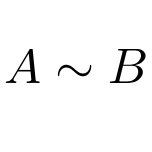Here you will find the explanation of similar matrices. We show you a clear example of two similar matrices and all the properties of this type of matrices so that you have no doubt. Finally, you’ll even see the relationship they have with congruent matrices.
Table of Contents
What are similar matrices?
The definition of similar matrices is as follows:
Two matrices A and B are similar if there is a matrix P with which they fulfill the following condition:
Or equivalently:
Actually, matrix P acts as a base change matrix. So what this equation means is that matrix A can be expressed in another base (P), which results in matrix B.
This term can also be called similarity transformation or conjugation, since we are actually transforming matrix A into matrix B.
Logically, matrix P has to be invertible or non-degenerate matrix (nonzero determinant).
On the other hand, it can be indicated that two matrices are similar with the following expression:

This type of matrices are very important for linear algebra. They are mainly used for diagonalizable matrices, since the method to diagonalize any matrix is based on the concept of matrix similarity.
The diagonalization of a matrix consists of calculating a similar matrix that, at the same time, is a diagonal matrix.
Example of similar matrices
Next we will study an example of similar matrices of dimension 2×2 to fully understand their meaning.
- Square matrices A and B are similar to each other through the invertible matrix P:
To prove that they are similar matrices, we must first find the inverse of matrix P:
See: how to find the inverse of a 2×2 matrix.
And now we check that they are similar by calculating the matrix product that defines the similarity of two matrices:

✅
The similarity relation is fulfilled, so they are similar matrices.
Properties of similar matrices
Two matrices A and B that are similar share the following characteristics:
- Two similar matrices have the same rank.
- The determinants of both matrices are equal.
- Two similar matrices have the same trace.
- Two similar matrices have the same eigenvalues, however, their eigenvectors are normally different.
See: eigenvalues and eigenvectors of a matrix.
- The characteristic polynomial and the minimum polynomial of two similar matrices are the same.
- A matrix and its transpose are similar.
- If matrices A and B are similar, matrix B can be found by applying elementary operations on the rows of matrix A, and vice versa.
- Obviously, the similarity between matrices is a reflective operation. That is, if A is similar to B, B is also similar to A.
- Furthermore, the similarity of matrices is also symmetric. In other words, if with matrix P we can obtain the matrix that is similar to A (B), we can also obtain the matrix that is similar to B (A) with the same matrix P:
- Similarity of matrices is also transitive. So if matrix A is similar to matrix B, and B is similar to matrix C, matrix A is also similar to matrix C.
- Finally, every matrix is similar with a matrix in row echelon form. And the following corollary can be deduced from this property: every square matrix is similar to a triangular matrix.
Congruent matrices
On the other hand, there is also another very similar relationship between matrices, but instead of being with the inverse matrix, it is with the transposed matrix. It’s called matrix congruence.
Two matrices A and B are congruent if there is an invertible matrix P with which the following equality holds:
As you can see, it is the analog of similar matrices but with the transpose of matrix P instead of its inverse.